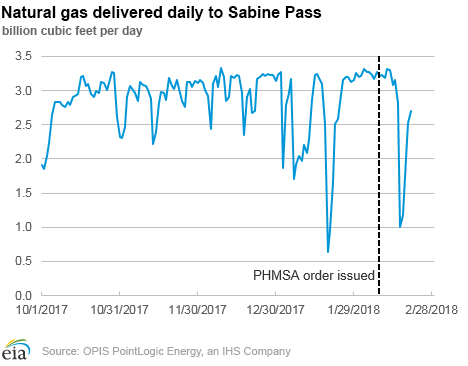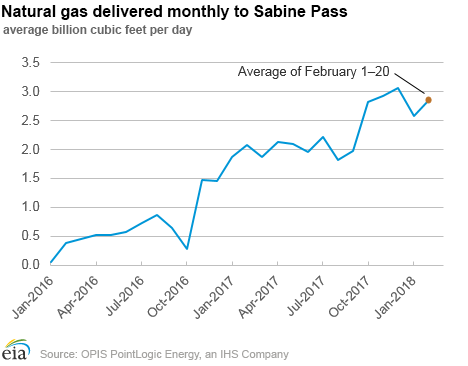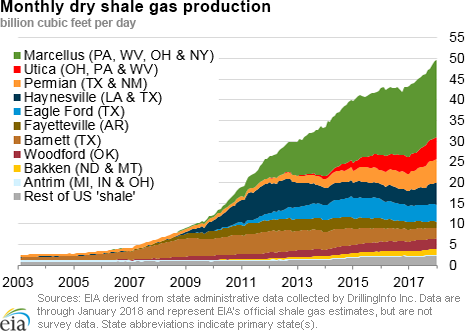In the News:
Two liquefied natural gas storage tanks are removed from service at the Sabine Pass Liquefaction Terminal
Cheniere Energy, operator of the Sabine Pass Liquefaction terminal in Louisiana, does not expect the removal of two storage tanks from service to affect the export levels of liquefied natural gas (LNG). The U.S. Pipeline and Hazardous Materials Safety Administration (PHMSA) issued an order on February 8 directing Sabine Pass to temporarily remove two of its five storage tanks from service after workers discovered a leak in one of the storage tanks on January 22. The tanks are used to store LNG after it has been liquefied, prior to loading it onto ships for export. The facility’s five tanks can hold the equivalent of 17.0 billion cubic feet (Bcf) of natural gas. Removing two tanks from service reduces this capacity to 10.2 Bcf-equivalent. For comparison, the average capacity of an LNG carrier leaving Sabine Pass is 3.6 Bcf-equivalent.
Since last October, Sabine Pass has been running four LNG production trains. According to data from PointLogic Energy, deliveries of natural gas to the terminal in December averaged 3.1 Bcf/d, the highest level since the facility began operations. January’s liquefaction volumes averaged 0.5 Bcf/d lower than December’s, in part because water supply issues at the plant led to reduced operations in the middle of the month. From February 1–20, pipeline natural gas feedstock deliveries to Sabine Pass averaged 2.8 Bcf/d of natural gas.
For reasons currently undetermined, LNG was released into the area between the inner and outer walls of the storage tanks, a space known as the annulus. The inner tank was built to handle temperatures as low as -260 degrees Fahrenheit (°F), and the outer wall was designed to handle temperatures as low as -25°F. Contact with the LNG caused cracks to form in the outer wall, which led to LNG escaping the annulus and pooling in the secondary containment area outside the tank.
On investigation of the leak, PHMSA found that a second tank, fabricated by the same company, had also experienced a release of LNG into its annulus. No liquid had leaked through the outer wall of this tank, although some vapor leakage occurred. This tank was also included in the shutdown order.
Before these tanks can be placed back into service, Sabine Pass must undertake a series of analyses and corrective actions and receive approval from PHMSA.
Overview:
(For the Week Ending Wednesday, February 21, 2018)
- Natural gas spot prices rose at most locations this report week (Wednesday, February 14 to Wednesday, February 21). The Henry Hub spot price rose from $2.51 per million British thermal units (MMBtu) last Wednesday to $2.65/MMBtu yesterday.
- At the New York Mercantile Exchange (Nymex), the March 2018 contract price rose 7¢ from $2.587/MMBtu last Wednesday to $2.659/MMBtu yesterday.
- Net withdrawals from working gas totaled 124 billion cubic feet (Bcf) for the week ending February 16. Working natural gas stocks are 1,760 Bcf, which is 26% less than the year-ago level and 19% lower than the five-year (2013–17) average for this week.
- The natural gas plant liquids composite price at Mont Belvieu, Texas, rose by 27¢, averaging $7.50/MMBtu for the week ending February 21. The price of ethane fell by 2%. The prices of natural gasoline and propane both rose by 3%, while butane and isobutane prices rose by 11% and 9%, respectively.
- According to Baker Hughes, for the week ending Tuesday, February 13, the natural gas rig count decreased by 7 to 177. The number of oil-directed rigs rose by 7 to 798. The total rig count remained at 975.
Prices/Supply/Demand:
Prices rise around the country. This report week (Wednesday, February 14 to Wednesday, February 21) the Henry Hub spot price rose 14¢ from $2.51/MMBtu last Wednesday to $2.65/MMBtu yesterday. At the Chicago Citygate, the price increased 13¢ from $2.44/MMBtu last Wednesday to $2.57/MMBtu yesterday. The price at PG&E Citygate in Northern California rose 55¢, from $2.79/MMBtu last Wednesday to $3.34/MMBtu yesterday after reaching a low of $2.71/MMBtu on Friday. The price at SoCal Citygate increased $14.49 from $4.43/MMBtu last Wednesday to $18.92/MMBtu yesterday.
From Friday to Tuesday, the price rose by $15.01/MMBtu at SoCal Citygate as temperatures fell and natural gas demand increased. On Friday, the high temperature in Los Angeles was 5 degrees Fahrenheit (°F) above seasonal norms and the low temperature was within the normal range, whereas on Tuesday the high temperature was within the normal range and the low was 10°F below normal. The lower temperatures affected demand for natural gas and resulted in three consecutive days when more than 1 Bcf of natural gas was withdrawn from storage. For more information, see EIA’s Southern California Daily Energy Report.
Northeast prices rise. At the Algonquin Citygate, which serves Boston-area consumers, the price went up 52¢ from $2.42/MMBtu last Wednesday to $2.94/MMBtu yesterday, reaching a high of $3.03/MMBtu on Thursday and a low of $2.30/MMBtu on Tuesday with mild temperatures. The price went up again on Wednesday, likely in anticipation of colder weather. At the Transcontinental Pipeline Zone 6 trading point for New York, prices this report week increased 26¢ from $2.45/MMBtu last Wednesday to $2.71/MMBtu yesterday.
The Tennessee Zone 4 Marcellus spot price increased 11¢ from $1.85/MMBtu last Wednesday to $1.96/MMBtu yesterday, with a high of $2.02/MMBtu on Thursday and a low of $1.73/MMBtu on Tuesday. The price at Dominion South in northwest Pennsylvania rose 19¢ from $1.98/MMBtu last Wednesday to $2.17/MMBtu yesterday, with a low of $1.97/MMBtu on Friday.
Nymex prices rise. At the Nymex, the price of the March 2018 contract increased 7¢, from $2.587/MMBtu last Wednesday to $2.659/MMBtu yesterday, as forecasts predicted colder weather in early March. The price of the 12-month strip averaging March 2018 through February 2019 futures contracts climbed 4¢ to $2.816/MMBtu.
Supply remains flat. According to data from PointLogic Energy, the average total supply of natural gas remained the same as in the previous report week, averaging 83.8 Bcf/d. Dry natural gas production remained constant week over week. Average net imports from Canada decreased by 4% from last week, but that change had little effect on overall supply.
Demand decreases significantly. Total U.S. consumption of natural gas fell by 14% compared with the previous report week, according to data from PointLogic Energy. Natural gas consumed for power generation declined by 4% week over week. Industrial sector consumption decreased by 6% week over week. Residential and commercial sector consumption declined by 24% week over week, largely because of warmer temperatures in the eastern half of the country. Natural gas exports to Mexico decreased 3%.
U.S. LNG exports decrease week over week. Three LNG vessels (LNG-carrying capacity 11.5 Bcf combined) departed the Sabine Pass liquefaction facility from February 14 to February 21. One tanker (LNG-carrying capacity 3.5 Bcf) was loading at the terminal on Wednesday.
Natural gas pipeline deliveries to the Sabine Pass terminal were down over the report week, averaging 2.2 Bcf/d, 1 Bcf/d (33%) lower than in the previous week. No tankers departed from Sabine Pass for most of the report week (February 14 – February 19). Bloomberg reported that six tankers were waiting outside the port of Sabine Pass for a loading window during this time.
Storage:
Working gas net withdrawals are 21 Bcf lower than the five-year average. Net withdrawals from storage totaled 124 Bcf for the week ending February 16, compared with the five-year (2013–17) average net withdrawal of 145 Bcf and last year's net withdrawals of 92 Bcf during the same week. Working gas stocks totaled 1,760 Bcf, which is 412 Bcf less than the five-year average and 609 Bcf less than last year at this time. Working gas stocks in all regions in the Lower 48 states are lower than year-ago levels.
Working gas levels are 343 Bcf above the five-year minimum. If net withdrawals from working gas stocks match the five-year average for the remainder of the withdrawal season, working gas stocks will total 1,290 Bcf by March 31, 2018, which is 24% below the five-year average, and the second lowest end of heating season level reported since 2010. Working gas stocks ended the 2013-14 heating season at 837 Bcf, which is the lowest reported level during the same period.
The average March 2018 futures contract price trades at a premium to the average weekly spot price. During the most recent storage week, the average natural gas spot price at the Henry Hub was $2.55/MMBtu, 3¢/MMBtu lower than the front-month futures price at the Nymex. A year ago, the spot price was 5¢ lower than the front-month contract.
Reported withdrawals out of storage are higher than the median of analysts’ expectations. According to the Desk survey of natural gas analysts, estimates of the weekly net change in working natural gas storage ranged from 105 Bcf to 129 Bcf, with a median of 121 Bcf. Prices for the futures contract for March delivery at the Henry Hub rose about 1¢/MMBtu, averaging $2.66/MMBtu, following the release of the Weekly Natural Gas Storage Report, with 89 contracts traded at the release. Prices remained close to that level in subsequent trading.
Temperatures are higher than normal during the storage week throughout most of the Lower 48 states. Temperatures in the Lower 48 states averaged 39 degrees Fahrenheit (°F), 3°F higher than the normal, 3°F lower than last year at this time, and 5°F above the average temperature of the prior storage week.
See also:
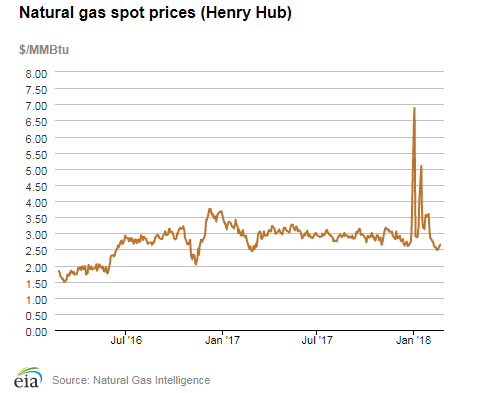
| Spot Prices ($/MMBtu) | Thu, 15-Feb |
Fri, 16-Feb |
Mon, 19-Feb |
Tue, 20-Feb |
Wed, 21-Feb |
|---|---|---|---|---|---|
| Henry Hub | 2.49 | 2.48 | Holiday | 2.61 | 2.65 |
| New York | 2.54 | 2.62 | Holiday | 2.52 | 2.71 |
| Chicago | 2.44 | 2.42 | Holiday | 2.55 | 2.57 |
| Cal. Comp. Avg.* | 2.48 | 2.51 | Holiday | 3.54 | 3.55 |
| Futures ($/MMBtu) | |||||
| March Contract | 2.580 | 2.558 | Holiday | 2.616 | 2.659 |
| April Contract | 2.620 | 2.598 | Holiday | 2.649 | 2.681 |
| *Avg. of NGI's reported prices for: Malin, PG&E Citygate, and Southern California Border Avg. | |||||
| Source: NGI's Daily Gas Price Index | |||||
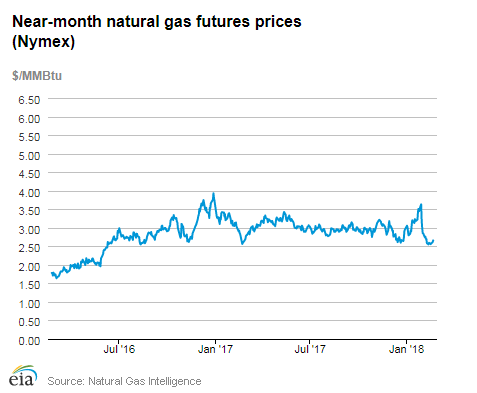
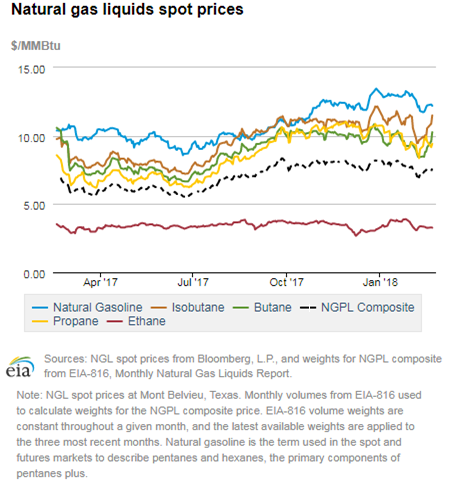
| U.S. natural gas supply - Gas Week: (2/15/18 - 2/21/18) | |||
|---|---|---|---|
Average daily values (Bcf/d): |
|||
this week |
last week |
last year |
|
| Marketed production | 87.6 |
87.6 |
78.8 |
| Dry production | 78.0 |
78.1 |
70.5 |
| Net Canada imports | 5.4 |
5.6 |
6.0 |
| LNG pipeline deliveries | 0.3 |
0.2 |
0.3 |
| Total supply | 83.8 |
83.9 |
76.8 |
|
Source: OPIS PointLogic Energy, an IHS Company | |||
| U.S. natural gas consumption - Gas Week: (2/15/18 - 2/21/18) | |||
|---|---|---|---|
Average daily values (Bcf/d): |
|||
this week |
last week |
last year |
|
| U.S. consumption | 74.8 |
86.5 |
68.8 |
| Power | 22.9 |
23.8 |
20.3 |
| Industrial | 21.9 |
23.2 |
21.2 |
| Residential/commercial | 30.1 |
39.5 |
27.3 |
| Mexico exports | 4.3 |
4.4 |
4.1 |
| Pipeline fuel use/losses | 5.9 |
6.8 |
5.4 |
| LNG pipeline receipts | 2.1 |
3.2 |
2.3 |
| Total demand | 87.1 |
100.9 |
80.7 |
|
Source: OPIS PointLogic Energy, an IHS Company | |||
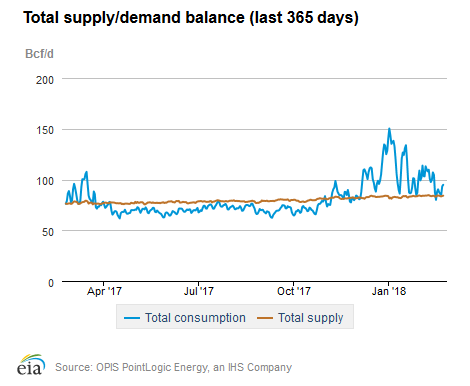
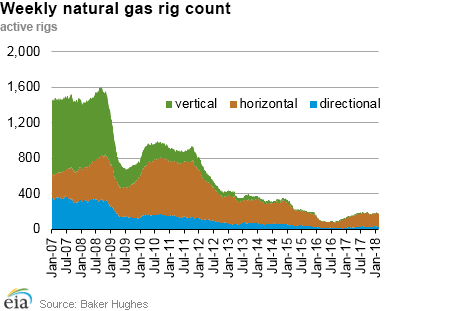
| Rigs | |||
|---|---|---|---|
Fri, February 16, 2018 |
Change from |
||
last week |
last year |
||
| Oil rigs | 798 |
0.9% |
33.7% |
| Natural gas rigs | 177 |
-3.8% |
15.7% |
| Note: Excludes any miscellaneous rigs | |||
| Rig numbers by type | |||
|---|---|---|---|
Fri, February 16, 2018 |
Change from |
||
last week |
last year |
||
| Vertical | 65 |
-7.1% |
0.0% |
| Horizontal | 839 |
0.8% |
36.6% |
| Directional | 71 |
-2.7% |
-1.4% |
| Source: Baker Hughes Inc. | |||
| Working gas in underground storage | ||||
|---|---|---|---|---|
Stocks billion cubic feet (Bcf) |
||||
| Region | 2018-02-16 |
2018-02-09 |
change |
|
| East | 403 |
432 |
-29 |
|
| Midwest | 428 |
468 |
-40 |
|
| Mountain | 111 |
122 |
-11 |
|
| Pacific | 204 |
213 |
-9 |
|
| South Central | 614 |
649 |
-35 |
|
| Total | 1,760 |
1,884 |
-124 |
|
| Source: U.S. Energy Information Administration | ||||
| Working gas in underground storage | |||||
|---|---|---|---|---|---|
Historical comparisons |
|||||
Year ago (2/16/17) |
5-year average (2013-2017) |
||||
| Region | Stocks (Bcf) |
% change |
Stocks (Bcf) |
% change |
|
| East | 438 |
-8.0 |
451 |
-10.6 |
|
| Midwest | 616 |
-30.5 |
531 |
-19.4 |
|
| Mountain | 147 |
-24.5 |
138 |
-19.6 |
|
| Pacific | 206 |
-1.0 |
229 |
-10.9 |
|
| South Central | 962 |
-36.2 |
823 |
-25.4 |
|
| Total | 2,369 |
-25.7 |
2,172 |
-19.0 |
|
| Source: U.S. Energy Information Administration | |||||
| Temperature – heating & cooling degree days (week ending Feb 15) | ||||||||
|---|---|---|---|---|---|---|---|---|
HDD deviation from: |
CDD deviation from: |
|||||||
| Region | HDD Current |
normal |
last year |
CDD Current |
normal |
last year |
||
| New England | 209 |
-53 |
-67 |
0 |
0 |
0 |
||
| Middle Atlantic | 198 |
-52 |
-32 |
0 |
0 |
0 |
||
| E N Central | 269 |
-4 |
47 |
0 |
0 |
0 |
||
| W N Central | 303 |
26 |
94 |
0 |
0 |
0 |
||
| South Atlantic | 101 |
-64 |
-23 |
18 |
11 |
7 |
||
| E S Central | 103 |
-61 |
-11 |
1 |
1 |
-1 |
||
| W S Central | 109 |
-3 |
51 |
6 |
2 |
-7 |
||
| Mountain | 194 |
-12 |
49 |
0 |
-1 |
-1 |
||
| Pacific | 101 |
-3 |
22 |
0 |
0 |
0 |
||
| United States | 184 |
-19 |
22 |
4 |
3 |
0 |
||
|
Note: HDD = heating degree day; CDD = cooling degree day Source: National Oceanic and Atmospheric Administration | ||||||||
Average temperature (°F)
7-Day Mean ending Feb 15, 2018
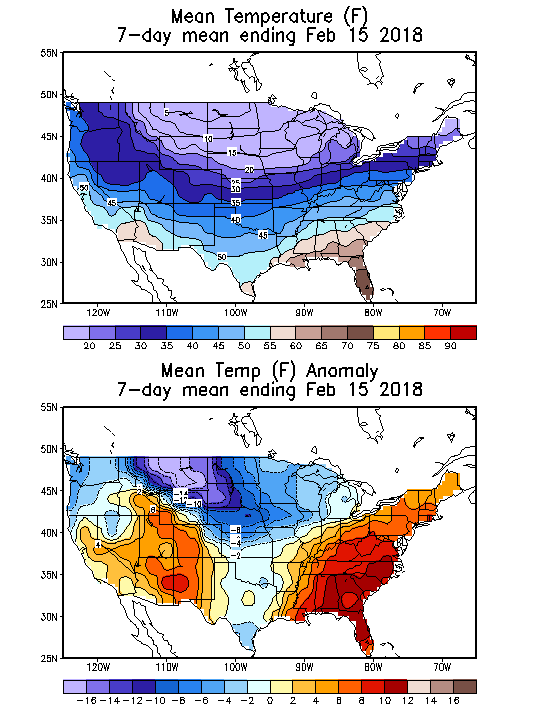
Source: NOAA National Weather Service
Deviation between average and normal (°F)
7-Day Mean ending Feb 15, 2018

Source: NOAA National Weather Service

